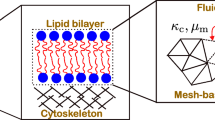Summary
The elastic modulus, ε, for the cell wall ofHalicystis parvula (defined by\(\varepsilon = V\frac{{dP}}{{dV}}\)) was determined by two different ways:
-
1)
By measuring the stationary pressure-volume curve and by calculating the long-term elastic coefficient,ɛ s, from the slope of the curve at a given volume and
-
2)
By measuring differential changes in cell turgor pressure and cell volume using the pressure probe technique and by calculating the short-term elastic coefficient, ε, according to the definition equation. The values of the elastic coefficients differ considerably and show different dependences on cell turgor pressure.ɛ s is about 0.5 to 2 bar, and is therefore in agreement with measurements of Graves and Gutknecht (Graves, J., Gutknecht, J. (1976)J. Gen. Physiol. 67 ∶ 579) on perfused cells ofH. parvula.ɛ s is almost pressure independent within the pressure range of 0.05 to 0.9 bar.
On the other hand, ε assumes values of about 1 to 2 bar at a low pressure (about 0.05 to 0.15 bar) and increases to about 16 bar at 0.9 bar turgor pressure. Evidence is presented that the short-term elastic coefficient, ε, determined from differential changes in cell turgor pressure,dP, and cell volume,dV, reflects the true elastic properties of the cell wall, whereas the long-term elastic coefficient,ɛ s, also includes other mechanical properties of the cell wall, which could not be identified up to now. The hydraulic conductivity,L p, of the cell membrane ofH. parvula was determined by directly measuring both the turgor pressure relaxation process (pressure probe) and the volume changes (microscope) in response to osmotic stress.L p was calculated from the slope of volume-time curves without knowledge of the elastic modulus. It has a value of about 0.8 to 2×10−6 cm sec−1 bar−1. The calculation ofL p from the turgor pressure relaxation process leads to identical results when using the short-term elastic coefficient. Under these conditionsL p assumes values of about 1.5 to 2.5×10−6 cm sec−1 bar−1.L p increases as the plasmolytic point is approached.
The result demonstrates that the short-term elastic coefficient determined by the pressure probe technique controls the instantaneous water transport between the cell interior and the external medium. The high extensibility of the cell wall (resulting from the low elastic coefficient) is the reason whyH. parvula exhibits a change in cell volume rather than a change in cell turgor. The results are discussed in relation to pressure measurements in individual cells of higher plant tissues.
Similar content being viewed by others
References
Blinks, L.R. 1934. Protoplasmic potentials inHalicystis. IV. Vacuolar perfusion with artificial sap and sea-water.J. Gen. Physiol. 18:409
Cleland, R. 1971. Cell wall extension.Annu. Rev. Plant Physiol. 22:197
Dainty, J. 1963. Water relations of Plant cells.Adv. Bot. Res. 1:279
Dainty, J. 1972. Plant water relations: The elasticity of the cell wall.Proc. R. Soc. Edinburgh A 70:89
Graves, J., Gutknecht, J. 1976. Ion transport studies and determination of the cell wall elasticity in the marine algaeHalicystis parvula.J. Gen. Physiol. 67:579
Graves, J., Gutknecht, J. 1977a. Chloride transport and membrane potential in the marine algaHalicystis parvula.J. Membrane Biol. 36:65
Graves, J., Gutknecht, J. 1977b. Current-voltage relationship and voltage sensitivity of the Cl-pump inHalicystis parvula.J. Membrane Biol. 36:83
Gutknecht, J., Hastings, D.F., Bisson, M.A. 1978. Ion transport and turgor pressure regulation in giant algal cells.In: Membrane Transport in Biology. G. Giebisch, D.C. Tosteson, and H.H. Ussing, editors. pp. 125–174 Springer Verlag, Berlin-Heidelberg-New York
Hüsken, D., Steudle, E., Zimmermann, U. 1978. Pressure probe technique for measuring water relations of cells in higher plants.Plant Physiol. 61:158
Kamiya, N., Tazawa, M., Takata, T. 1963. The relation of turgor pressure to cell volume inNitella with special reference to mechanical properties of the cell wall.Protoplasma 57:501
Kedem, O., Katchalsky, A. 1958. Thermodynamic analysis of the permeability of biological membranes to non-electrolytes.Biochim. Biophys. Acta 27:229
Kornmann, P. 1938. Zur Entwicklungsgeschichte von Derbesia und Halicystis.Planta 28:464
Philip, J.R. 1958. The osmotic cell wall, solute diffusibility, and the plant water economy.Plant Physiol. 33:264
Steudle, E., Lüttge, U., Zimmermann, U. 1975. Water relations of epidermal bladder cells of the hylophytic speciesMesembryanthemum crystallinum: Direct measurements of the hydrostatic pressure and hydraulic conductivity.Planta 126:229
Steudle, E., Zimmermann U. 1974. Determination of the hydraulic conductivity and of reflection coefficients inNitella flexilis by means of direct cell-turgor pressure measurements.Biochim. Biophys. Acta 332:399
Steudle, E., Zimmermann, U., Lüttge, U. 1977. Effect of turgor pressure and cell size on the wall elasticity of plant cells.Plant Physiol. 59:285
Tazawa, M., Kamiya, N. 1965. Water relations of a Characean internodal cell.Annu. Rev. Biol. Works Fac. Sci. Osaka 13:123
Zimmermann, U. 1978. Physics of turgor- and osmoregulation.Annu. Rev. Plant Physiol. 29:121
Zimmermann, U., Hüsken, D. 1979. Theoretical and experimental exclusion of errors in the determination of the elasticity and water transport parameters of plant cells by the pressure probe technique.Plant Physiol. 64:18
Zimmermann, U., Steudle, E. 1974a. The pressure dependence of the hydraulic conductivity, the membrane resistance and membrane potential during turgor pressure regulation inValonia utricularis.J. Membrane Biol. 16:331
Zimmermann, U., Steudle, E. 1974b. Hydraulic conductivity and volumetric elastic modulus in giant algal cells: Pressure- and volume-dependence.In: Membrane Transport in Plants. U. Zimmermann, and J. Dainty, editors. pp. 64–71. Springer Verlag, Berlin-Heidelberg-New York
Zimmermann, U., Steudle, E. 1978. Physical aspects of water relations of plant cells.Adv. Bot. Res. 6:45
Zimmermann, U., Steudle, E. 1980. Fundamental water relations parameters.In: Plant Membrane Transport: Current Conceptual Issues. R.M. Spanswick, W.J. Lucas, and J. Dainty, editors. pp. 113–127. Elsevier/North-Holland, Amsterdam
Author information
Authors and Affiliations
Rights and permissions
About this article
Cite this article
Zimmermann, U., Hüsken, D. Turgor pressure and cell volume relaxation inHalicystis parvula . J. Membrain Biol. 56, 55–64 (1980). https://doi.org/10.1007/BF01869352
Received:
Revised:
Issue Date:
DOI: https://doi.org/10.1007/BF01869352




